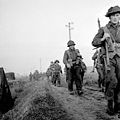This article needs additional citations for verification .(February 2012) |
| Royal Winnipeg Rifles | |
|---|---|
 Cap badge of the Royal Winnipeg Rifles | |
| Active | 1883–present |
| Country | Canada |
| Branch | Canadian Army |
| Type | Rifles |
| Part of | 38 Canadian Brigade Group |
| Garrison/HQ | Minto Armoury, Winnipeg, Manitoba |
| Nickname(s) | Little Black Devils |
| Motto(s) | Hosti acie nominati (Latin for 'Named by the enemy') |
| March | "Old Solomon Levi" |
| Engagements | |
| Battle honours | See #Battle honours |
| Website | www |
| Commanders | |
| Colonel-in-Chief | King Charles III |
| Notable commanders | William Nassau Kennedy |
| Abbreviation | R Wpg Rif |
The Royal Winnipeg Rifles (R Wpg Rif) are a Primary Reserve one-battalion infantry regiment of the Canadian Army. Nicknamed the "Little Black Devils", they are based at Minto Armoury in Winnipeg, Manitoba. The Royal Winnipeg Rifles are part of 3rd Canadian Division's 38 Canadian Brigade Group. [1]
Contents
- Lineage
- The Royal Winnipeg Rifles
- The Winnipeg Light Infantry
- Lineage charts
- Perpetuations
- North-West Rebellion
- The Great War
- History
- Early history
- The First World War
- 1920s-1930s
- The Second World War
- Post-WWII to the Present
- Structure
- The Royal Winnipeg Rifles Band
- Traditions
- Alliances
- Battle honours
- Recognition
- Royal Canadian Army Cadets
- Notable members
- Victoria Cross holders
- The Royal Winnipeg Rifles Museum and Archives
- Media
- See also
- Order of precedence
- Notes
- References
- External links






